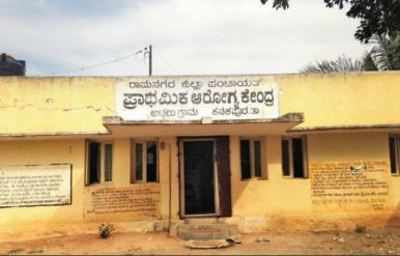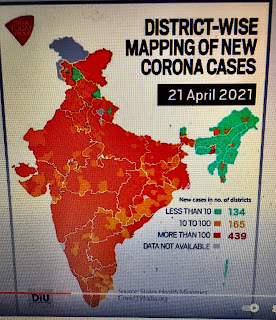We need to focus on healthcare in rural districts.
The title may appear to be a ‘banal’ political statement. However I am serious!
My earlier blog expressed our worries as super- seniors! A comment made by Pradip Grama*, my golf buddy, focuses on a major worry that needs to be addressed . (*While we met some years ago, our ancestors come from the same Grama, now a town!)
".... What's happening now is cumulative effect of giving lowest priority to health care. Britishers didn't care. Successive govt. followed British strategy. ......India spends 3.5% of GDP on healthcare, compared to US 17%, Europe 11.5% average.
We have enough ventilators but no trained personnel to use it. Same problem with oxygen. If you had oxygen, there aren't enough hospitals to accommodate. Added to poor infra, inefficient bureaucracy and corruption makes a deadly potion."
It is a vital issue and the report by Ministry of Health and Family Welfare is a good place to start !
Hospitals in the Country: Posted On: 24 JUL 2018 PIB
"Public health and hospitals being a State subject, State Governments are primarily responsible for up-keeping, providing health care to people and maintaining information of hospitals....:”
The report has details of health centres, hospitals and beds all across India and also of AYUSH , Defence, Railway and ESI across India.
 |
| Just 23 kms away from Bangalore! |
There is hope, as per Logical Indian in Nov 2020. "In a meeting with former health ministers and MLAs (who are also doctors) at the Vidhana Soudha, he also said apart from the upgradation, the state will now also come up with a new policy for this purpose. With the COVID-19 pandemic bringing our attention to various aspects of health services, he said it is important to improve the existing facilities in the state. As per data, there are total 2,300 PHCs in the state. In order to make the existing PHCs function as clinics, the state is securing from World Bank funding."
The details below give us an idea of the present status.
*(The primary tier consists of a Sub-Centre (SC) for a population of 3000-5000, a Primary Health Centre (PHC) for 20000 to 30000 people and a Community Health Centre (CHC) as referral centre for every four PHCs covering a population of 80,000 to 1.2 lakh.
There were 29,899 PHC's and 5588 CHC centres. Hospitals at sub-district are 1255 and district 1003. The numbers of beds available adds up to 7,39,024 at the time of report on 2018.
Number of Government Hospitals and Beds in Rural Areas 19,810 and 2,79,588 and in Urban areas 3,772 and 4,31,173.)
(https://www.institutmontaigne.org/en/blog/private-healthcare-india-boons-and-banes)
"India has a total of 43,486 private hospitals, 1.18 million beds, 59,264 ICUs, and 29,631 ventilators. On the other hand, there are 25,778 public hospitals, 713,986 beds, 35,700 ICUs, and 17,850 ventilators. Total private infrastructure accounts for nearly 62% of all of India’s health infrastructure. "
"The capacity of most public hospitals and private hospitals is the same in the states (measured by beds to hospitals ratio, ICU to hospitals ratio, and ventilator to hospitals ratio)."
The report highlights the inability of the middle class to meet the cost of treatment, including Covid, which is high in a private hospital. Also the limitations of the Ayushman Bharat. It appears this scheme is a quick fix* .
(*Ayushmaan Bharath has helped BPL card holders to get free treatment for upto 5 L per annum even in private hospital. Over 2 cr poor people have benefited. Government need not have spent this money if there were good facilities in government hospitals...Pradip )
 |




Comments